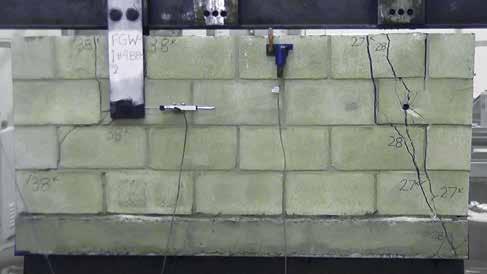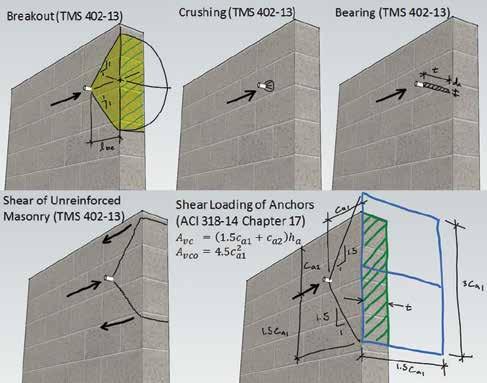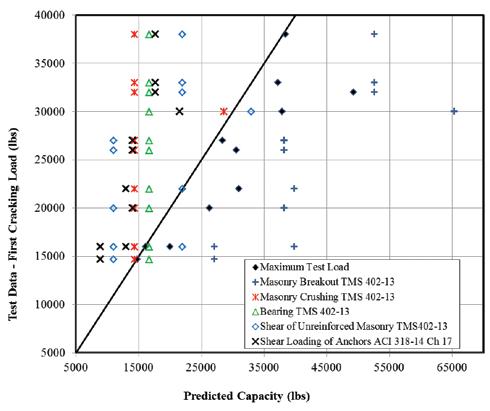
9 minute read
LESSONS LEARNED
As voluminous as our codes have become, they do not provide guidance to all situa tions. Students in structural design classes often ask the professor, “What is the procedure I need to follow?” The question they should be asking is “What is the underlying behavior?” Only then will they begin to develop engineering judgment and be able to correctly implement code provisions in their designs. Experienced engineers know that there are many instances in which engineering judgment is needed to move a design forward; the code allows for judgment based on a “rational analysis.” The underlying structural behavior informed by fundamental engineering principles can be used to build on a code provision. An engineer’s willingness to provide a client a design based on a rational analysis will be subject to the perceived risks and benefits associated with the design. The following are lessons learned from a limited number of tests performed on structural connections between steel and masonry elements of hybrid masonry seismic structural systems. The goal of this article is to help practitioners gain a better understanding of the behavior of throughbolted masonry connections so that they can appropriately implement existing code provisions into designs prior to more data being developed.
Hybrid Masonry Overview
Hybrid masonry was introduced as a structural system concept in 2007. The system is composed of a structural steel frame and reinforced concrete masonry panels. Hybrid masonry offers a design alternative to braced frames and moment-resisting frames that are appropriate for low and mid-rise construction. It is best suited for cases where a structural steel framing system and masonry walls would naturally be chosen due to structural and architectural efficiency. Hybrid masonry includes three distinct types of load transfer, which are shown in Figure 1. In Type I Hybrid Masonry (Figure 1a), steel connectors transfer in-plane shear between the steel frame and the top of the masonry panel. These connectors can be either rigid link plates or ductile fuse plates. The connectors do not transfer any vertical load to the masonry wall, but their design can Lhave a significant influence on the overall performance of the system. In Type II and III Hybrid essons
Masonry (Figure 1b and Figure 1c), headed studs Lare used to transfer shear from the beam and/or columns to the masonry panel. Vertical load is earned also transferred directly through contact from the beam to the top of the masonry panel. In its simplest form (Type I), hybrid masonry consists of reinforced concrete masonry panels connected to the surrounding steel frame such problems and solutions encountered by practicing structural engineers that story shears can be transferred from the floor beams to the masonry. The masonry panel is constructed in-plane with the steel frame, supported on the floor beam or foundation below the panel. Steel connector plates between the masonry panel and the floor beam above the panel transfer only horizontal story shears (Figure 1a). The masonry does not make contact with the upper beam or columns other than through-bolts in vertically slotted holes in the connector plates, which are designed either as ductile “fuse” or elastic “link” connectors. The structural masonry panel acts Hybrid Masonry Connections and Through-Boltsas a surrogate-bracing member and can be reinforced both vertically and horizontally to resist in-plane and out of plane lateral forces. By Gaur Johnson, Ph.D., S.E. and Hybrid Masonry Types II and III are designed Ian Robertson, Ph.D., S.E. to transfer both shear and vertical load from the steel beam to the top of the masonry panel and, in the case of Type III, to transfer shear between the panel and the steel columns (Figure 1b and Figure 1c). Shear transfer is achieved through the use of headed studs welded to the beam and columns and embedded in the grouted cells, or formed bond beams, of the concrete masonry panel. All inelastic activity is focused in the masonry Gaur Johnson is an Assistant panel, while the steel frame and headed studs are Professor at the University of designed with an overstrength factor to remain Hawaii at Manoa. Gaur can be elastic during a design level seismic event. reached at gaur@hawaii.edu. Ian Robertson is a Professor
Through-Bolt Connectors of Structural Engineering in The performance of hybrid masonry is highly dependent upon the performance of the connectors. Therefore, much of the research on hybrid masonry the Department of Civil and Environmental Engineering at the University of Hawaii at Manoa. Ian can be reached at ianrob@hawaii.edu.
(b) (c)
has uncovered some important information on the performance of masonry connectors that are not directly addressed in the masonry standard or building codes. Due to space considerations, this article will only address through-bolted connections. However, Part 2 of the article, in an upcoming issue of STRUCTURE, will address hybrid masonry steel plate connectors and headed studs in bond beams. The practicing engineer, whether designing hybrid masonry or conventional reinforced masonry, will find that added information useful. Limit State Low
Pcr/Pn High
Pcr/Pn Mean Pcr/Pn COV
Masonry Breakout TMS 402-13 0.402 0.723 0.583 0.164
Masonry Crushing TMS 402-13
1.029 2.659 1.652 0.330 Bearing TMS 402-13 0.883 2.282 1.500 0.299 Shear of Unreinforced Masonry TMS 402-13 0.729 2.459 1.525 0.345 Shear Loading of Anchors ACI 318-14 1.232 2.152 1.708 0.150
Local Failure of Masonry at Through-bolts
For the hybrid masonry system to function correctly, it is essential that through-bolt connections between the masonry panel and the connection plates are able to transfer the required load without premature failure. However, many engineers also use throughbolts for conventional masonry construction. Local masonry failure mechanisms caused by a horizontal point load introduced into a bond beam via through-bolts is not addressed by any code. Is it appropriate to extrapolate existing provisions for anchors which load one face of the wall to the through-bolts? A test setup which monotonically loaded a single through-bolt toward the end of a CMU wall was used to estimate a lower bound capacity of the masonry. Figure 2 shows one of the wall specimens after two tests. Damage on the right was caused when a through bolt in

Figure 2. Through-bolt test specimen.
the second cell from the end of the wall was loaded towards the right. Damage on the left was caused by the load applied to the left at the side plates and through-bolt shown. Details of the test setup, results and discussion can be found in an upcoming TMS Journal article titled Capacity of Masonry Loaded by Through-Bolts in Double Shear and other reports and conference proceedings. The results were compared with code specified limit states from TMS 402-13 and ACI 318-14 which could potentially be used with engineering judgment. The TMS 402-13 limit states of masonry breakout at anchors, masonry crushing at anchors, bearing, and shear were considered. The ACI 318-14 limit state of shear loading of anchors was also considered. The formulation for each limit state can be found online at www.STRUCTUREmag.org. Figure 3 illustrates each limit state as implemented for through-bolts. Figure 4 shows a plot of the predicted capacity of each limit state considered, versus the test data corresponding to the first cracking load observed during testing. Points to the left of the diagonal line indicate a conservative under-prediction of the capacity while points to the right indicate an overprediction. The data series labeled Maximum Test Load shows the reserve or additional strength beyond the first cracking for each specimen. The TMS 402-13 limit state equation for masonry breakout clearly and consistently overpredicts the capacity. Indeed, in most cases, the prediction also exceeds the maximum test load which is shown in the figure and indicates



Build Your Career with Us
Figure 4. Test data versus predicted capacity from various specifi cations.
the additional observed strength beyond fi rst cracking during the tests. Th e TMS limit states of masonry crushing at anchors and bearing are both a function of the bolt diameter and number of bolts – they do not appear to limit the connections capacity. Prediction using shear of unreinforced masonry generally was less than the actual tested capacity; however, it was an unconservative prediction in two cases. Th e ACI shear loading of anchors limit state provided a consistently conservative prediction. Th is data is not defi nitive especially considering the limited number of tests; however, it is instructive to know that the masonry breakout limit state equation is severely overpredicting capacity. For each limit state evaluated, the Table gives the low, high and mean ratio of the fi rst cracking load to the predicted nominal capacity (Pcr/Pn) as well as the coeffi cient of variation. Values of Pcr/Pn less than 1.0 indicate that the predicted nominal capacity is unconservative. Th e ACI shear loading of anchors and the TMS masonry breakout of anchors limit states have a signifi cantly lower coeffi cient of variation compared to the other limit states. Th e observed failures are consistent with the theoretical failure shown in Figure 3.
Conclusions
Practitioners who use through-bolt connection details described in this article will not be able to fi nd code language or limit states that directly address the behavior, boundary conditions and loading which can make these connections cost eff ective for hybrid masonry systems. Th ey must rely on engineering judgment and should consider the following information. Local Masonry Failure at Through-Bolts • Based on the limited test data, TMS 402-13 masonry breakout of anchors and ACI 318-14 shear loading of anchors appear to provide the best correlation to the likely failure mechanism of masonry when a through bolt is installed near an edge. However, only ACI 318-14 shear loading of anchors can be used unaltered – it will provide a conservative result (the mean failure of the tests performed is 171% of the predicted nominal capacity). • Th e TMS 402-13 masonry breakout of anchors limit state should be reduced signifi cantly prior to it being applicable to predict the capacity at these connections.
Th e mean failure of the tests performed is 58% of the predicted capacity which means that, even after using the strength reduction factor of 0.60, there will still be a 50% probability of failure at the design level load. • Engineering judgment is required to incorporate these into a design.
Further testing is needed to justify any specifi c code provisions being adopted for these connections.▪
Take your career in a new direction. Engineers at Simpson Strong‑Tie affect building construction on a massive scale – helping our customers design and build safer, stronger structures all over the globe.
We have multiple openings for structural engineers who enjoy working on innovative and challenging projects, giving presentations and being on jobsites. Learn more and apply at
strongtie.com/engineerjobs.









